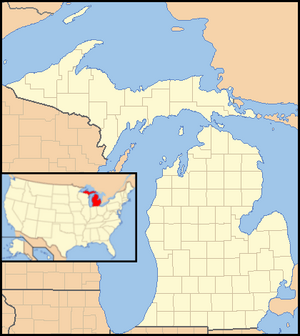List of amphibians of Michigan facts for kids
Michigan is home to twenty-six different kinds of amphibians. These amazing creatures include twelve types of frog, twelve types of salamander, and two types of toad. All of them belong to a group of animals called Amphibia.
Some of Michigan's amphibians need special protection. For example, the Blanchard's cricket frog is considered threatened. This means its population is getting smaller. Two other species, the marbled salamander and the small-mouth salamander, are even more at risk; they are considered endangered. The state of Michigan has laws, like the Endangered Species Act, to help protect these animals. Other species, like the boreal chorus frog and lesser siren, are also a special concern, even if they don't have the same legal protection.
Contents
How Michigan's Amphibians Survive the Cold
Most frogs and toads around the world live in warm, tropical places. But Michigan can get very cold! Amphibians are ectothermic, which means they are cold-blooded. Their body temperature changes with the temperature around them. Because of this, Michigan's amphibians have special ways to deal with freezing weather.
Many frogs and toads become inactive or dormant in the winter. Some frogs can even survive short periods of freezing. Some salamanders also hibernate during the colder months. However, some salamanders that live entirely in water stay active all year long.
Protecting Amphibians in Michigan
Amphibians face many dangers from human activities. Things like water pollution, cars, and the loss of their homes (called habitat destruction) can hurt them. When wetlands are destroyed for farming or by off-road vehicles, amphibians lose their homes. Chemical pesticides used on farms can also be harmful.
Luckily, Michigan has laws to protect its wetlands. These laws help prevent pollution and destruction. Also, some wetlands that were once used for farming are now being restored to their natural state. This gives amphibians more safe places to live.
Amphibian Habitats Across Michigan
Michigan's amphibian homes are generally divided into four main areas. These areas are different because of their climate, soil, and landforms left behind by glaciers.
Southern Lower Peninsula: Region One
This area generally has warmer weather that doesn't change as much. The soil here is mostly loamy and clay, with some sand. You'll find many deciduous hardwood trees, which lose their leaves in the fall. There are also some natural prairies and savannas. This region has the most different types of plants and animals, including some found nowhere else in Michigan.
Northern Lower Peninsula: Region Two
This region is cooler and has more changing weather, with more rain and snow. This is partly because it's closer to the Great Lakes. It also has more uplands (higher ground) and is further north. The soil is mostly sandy and has glacial deposits. Forests here are often conifer (like pine trees) or a mix of conifer and hardwood trees. You'll also find more swamps and bogs here than in the southern part of the state.
Eastern Upper Peninsula: Region Three
The climate here is similar to the northern Lower Peninsula. The soil is mostly sand and clay, and it doesn't have many nutrients. It also doesn't drain water very well. This region has many wetlands with conifer forests. Higher areas have a mix of conifer and broadleaf hardwood trees.
Western Upper Peninsula: Region Four
This area has a lot of bedrock (solid rock under the soil). The temperatures here are not as mild as in other regions. Winters can be very cold, and summers can be hot. Like Region Three, you'll find mixed conifer and broadleaf forests here.
Frogs in Michigan
| Scientific name | Common name | Description | Image | Notes |
|---|---|---|---|---|
| Acris crepitans blanchardi | Blanchard's cricket frog | Adults are about 1 inch (2.5 cm) long and are brown or gray. | 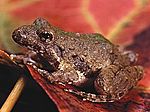 |
Considered a threatened species in Michigan. |
| Hyla chrysoscelis | Cope's gray tree frog | Adults are 1.5 to 2 inches (3.8 to 5.1 cm) long and can be gray, green, or brown. |  |
|
| Hyla versicolor | Gray tree frog | Adults are 1.5 to 2 inches (3.8 to 5.1 cm) long and can be gray, green, or brown. | 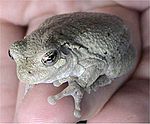 |
|
| Pseudacris crucifer crucifer | Northern spring peeper | Adults are 1 to 1.5 inches (2.5 to 3.8 cm) long and are light brown or tan. | 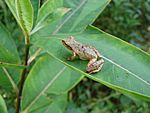 |
|
| Pseudacris maculata | Boreal chorus frog | Adults are about 1.5 inches (3.8 cm) long and are pale gray or brown. Some can be red or bright green. |  |
Only found on Isle Royale in Michigan. It's a species of special concern. |
| Pseudacris triseriata triseriata | Western chorus frog | Adults are 1 to 1.5 inches (2.5 to 3.8 cm) long and are brown with dark stripes. |  |
|
| Rana catesbeiana | Bullfrog | Adults are 3 to 8 inches (7.6 to 20.3 cm) long and can be green, brown, or olive. | 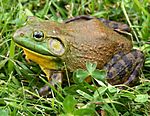 |
|
| Rana clamitans melanota | Northern green frog | Adults are 2.5 to 4 inches (6.4 to 10.2 cm) long and can be green, brown, or olive. | 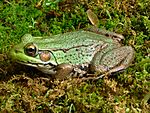 |
|
| Rana palustris | Pickerel frog | Adults are 2 to 3 inches (5.1 to 7.6 cm) long and are green or brown with dark square spots. |  |
|
| Rana pipiens | Northern leopard frog | Adults are 2 to 3.5 inches (5.1 to 8.9 cm) and are green or brown with dark round spots. | 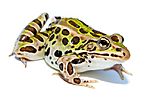 |
|
| Rana septentrionalis | Mink frog | Adults are 2 to 3 inches (5.1 to 7.6 cm) long and are a blotchy green or brown. | 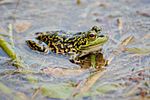 |
|
| Rana sylvatica | Wood frog | Adults are 2 to 2.5 inches (5.1 to 6.4 cm) long and are brown or tan. | 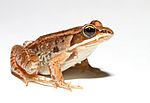 |
Salamanders in Michigan
| Scientific name | Common name | Description | Image | Notes |
|---|---|---|---|---|
| Ambystoma laterale | Blue-spotted salamander | Adults are 3.5 to 5.5 inches (8.9 to 14.0 cm) long and are black with turquoise or pale blue spots. |  |
|
| Ambystoma maculatum | Spotted salamander | Adults are 4.3 to 9.8 inches (11 to 25 cm) long and are black or dark gray with round yellow spots. | 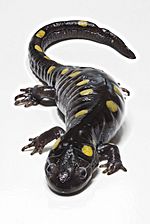 |
|
| Ambystoma opacum | Marbled salamander | Adults are 3.5 to 5 inches (8.9 to 12.7 cm) long and are black or dark gray with white or gray markings. |  |
Considered an endangered species in Michigan. |
| Ambystoma texanum | Small-mouth salamander | Adults are 4.3 to 7 inches (11 to 18 cm) long and are black, gray, or brown. |  |
Considered an endangered species in Michigan. |
| Ambystoma tigrinum tigrinum | Eastern tiger salamander | Adults are 7 to 13 inches (18 to 33 cm) long and are black, brown, or olive with yellow or brown spots. |  |
|
| Ambystoma tremblayi | Tremblay's salamander | This is a hybrid salamander, hard to tell apart from the blue-spotted salamander. | It has been seen near Ann Arbor, Michigan. | |
| Eurycea bislineata | Northern two-lined salamander | Adults reach 3.5 inches (8.9 cm) long and are usually yellow with two dark lines along their body. | 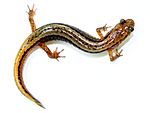 |
Only known to be found at Murphy Lake State Game Area in Tuscola County in eastern Michigan. |
| Hemidactylium scutatum | Four-toed salamander | Adults are 2 to 4 inches (5.1 to 10.2 cm) long and are orange to gray-brown with small black or blue speckles. | 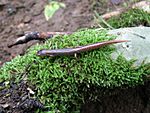 |
|
| Necturus maculosus | Mudpuppy | Adults are 8 to 19 inches (20 to 48 cm) long and are black or gray-brown with dark splotches. | 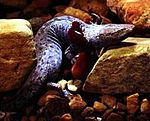 |
|
| Notophthalmus viridescens | Eastern newt | Adults are 2.5 to 5.5 inches (6.4 to 14.0 cm) long and are olive green to greenish brown. |  |
|
| Plethodon cinereus | Red-backed salamander | Adults are 2.3 to 5 inches (5.8 to 12.7 cm) long and are usually dark. They have a red stripe on their back when they are young. |  |
|
| Siren intermedia nettingi | Western lesser siren | Adults are 7 to 19.7 inches (18 to 50 cm) long and are gray, brown, or olive. |  |
Considered a species of special concern in Michigan. |
Toads in Michigan
| Scientific name | Common name | Description | Image | Notes |
|---|---|---|---|---|
| Bufo americanus americanus | Eastern American toad | Adults are 2 to 4 inches (5.1 to 10.2 cm) long with warty brown skin. | 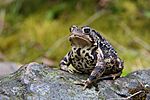 |
|
| Bufo fowleri | Fowler's toad | Adults are 2 to 3.5 inches (5.1 to 8.9 cm) long with warty brown skin. |  |
See also


